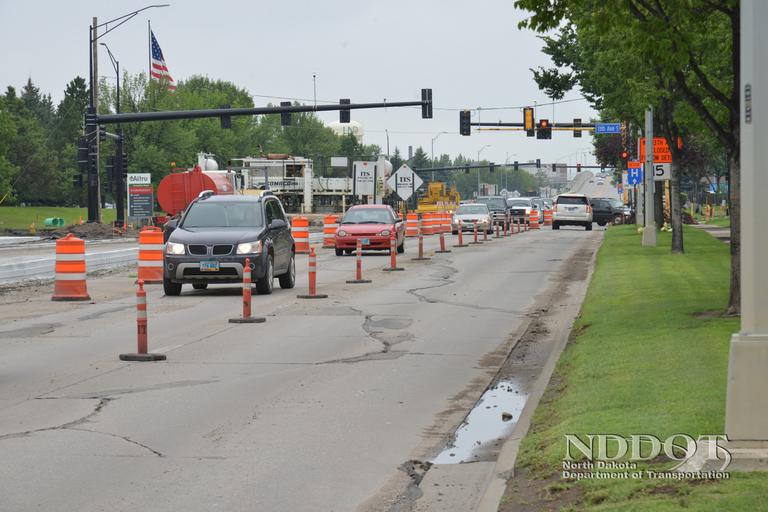
The most common collision in a work zone is a rear-end collision from a vehicle that refuses to slow down and rear-ends another vehicle, or a driver who is distracted either by changing the radio station, using a mobile phone, etc., or failing to yield to right-of-way and obey stop signs and rear-ends another vehicle.
Driving in a work zone requires extra carefulness. Drivers are expected to use their A-game to ensure there is no form of collision.
The Most Common Collision in a Work Zone is From?
The most common collision in a work zone is a rear-end collision. This happens when a driver follows too closely behind another vehicle and fails to slow down in time, causing them to crash into the back of the car in front.
Speeding is the most common cause of collision in a work zone. In 2018, driving at a high speed was the major cause of 52% of all the crashes that occurred in work zones.
Failure of drivers to yield to the various signs and signals is one of the other leading causes of accidents in work zones. This happens when drivers fail to stop their car when they come to a stop sign or a traffic control device such as the flashing lights or arrows that show as a result of overspeeding.
When drivers pass a stop sign without stopping because they were driving at a speed that was too high, they can end up running into a ditch or anything that the sign was preparing or protecting them from.
How to Avoid Work Zone Collision
To avoid becoming a victim of accidents that occur in work zones, drivers should:
1. Slow Down and Drive Within the Speed Limit
As a driver, slow down and drive within the posted speed limit when approaching any kind of work zone (or areas where construction activity is ongoing) do not drive too fast or too slowly.
This is because you do not know what is ahead in the work zone that you are driving into, so you should not drive into work zones at a very high speed.
2. Never Change Lanes Without Checking Your Mirror
Drivers should never change lanes without first checking their mirrors and blind spots for workers and equipment. By doing this, accidents that could have occurred from crashing into different equipment can be avoided.
Also, before changing any lane, ensure to use your turning signals to alert the motorist/driver following you that you are about to change lanes. This is very important.
3. Keep An Eye Out for Signs on the Road
It is also important that you keep an eye out for signs on the road that warn you about upcoming roadwork or construction projects along the highway or roadway that are being traveled.
4. Never Drive Through a Barricade or Around it
In a work zone, drivers should never drive through a barricade or around it. This is because barricaded roads are probably not finished or there could be things that are harmful on the road, whatever the reason for putting up the barricade is, it’s definitely to keep the road users safe.
Be careful when driving near workers who handle heavy machinery because it’s possible that they have not noticed that you are close by.
5. Stay Alert
Stay alert, don’t drive distracted in work zones, don’t drive fatigued, and don’t drive impaired. All of these would help you to avoid accidents in work zones.
Sometimes, apart from overspeeding, rear-end crashes in work zones are caused by drivers who are distracted either because they are changing the channels on the radio, using their mobile phones, or, eating while driving.
It can also be a driver who is moving and at the same time talking to someone or a construction worker on the side of the road.
It happened to me in a work zone and I hit the vehicle in the front because I was distracted and didn’t know the vehicle had stopped again.
The point we are trying to make here is that if you are distracted, you won’t know when the car in front has stopped. You will end up hitting it and causing an accident.
What is the Most Occurring Type of Collision?
The most common type of collision is the “fender bender”. This is when two vehicles that are usually of the same size and weight hit each other head-on. When this happens, both vehicles can suffer damage to their undercarriages, such as bent bumpers.
Fender benders account for more than half of all the crashes that have been recorded in work zones in the United States.
Another common type of collision is a situation where a driver hits another vehicle at an angle with its front end before the car flips over backward onto its roof or top surface.
This type of accident is called a rollover crash because the vehicle rolls over before it flips backward onto the roof or the top surface. The “rollover crash” is responsible for about 30% of all the accidents that have been recorded in work zones.
What are the Most Common Causes of Collision?
Here are some of the most common causes of collisions:
1. Distracted Driving
Several things can cause a collision while driving but the most common cause of collision on roads is distracted driving.
Being distracted while driving is responsible for so many collisions. Most times people try to drive and do so many other things at the same time which makes them not to be able to focus on the road. For example, driving and trying to operate their phones or trying to change the radio station or play a particular song.
2. Overspeeding
Speeding is another cause of the collision in a work zone and in all driving scenario. It might seem like you’re saving time by exceeding the speed limit, but the reality is that overspeeding increases your risk of a collision.
When you overspeed, you have less time to react to hazards or unexpected situations. By the time you see a danger and slam on the brakes, it might be too late. Moreover, it takes longer to stop a vehicle going at a higher speed, meaning that you could end up rear-ending the car in front of you if it slows down suddenly.
Overspeeding also makes it harder to maintain control of your vehicle, especially on curves or slippery roads. A sudden maneuver to avoid something could lead to a spinout or rollover accident.
3. Impaired Driving
Driving when you are impared through alcohol or drugs is another cause of collision. Alcohol and drugs impair your driving ability, judgment, coordination, and reaction time. Even small amounts can have a big impact on your ability to drive safely.
This is because, alcohol slows down your brain function, making it difficult to think clearly, react quickly, and make good decisions behind the wheel.
Also, depending on the drug, it can cause drowsiness, hallucinations, impaired coordination, and other effects that make driving extremely dangerous.
4. Aggressive Driving
Aggressive driving is a type of driving that is fueled by anger, impatience, and a sense of entitlement. When you drive aggressively, you will tailgate another car by following too closely behind the vehicle, hence, leaveing you with not enough room to stop safely if they brake suddenly.
You may also exceed the speed limit and weave in and out of traffic, putting yourself and others at risk.
5. Drowsy Driving
Just like being drunk, being tired behind the wheel is just as dangerous. Drowsiness slows down your reaction time and impairs your judgment, making it difficult to stay focused on the road.
Signs of drowsy driving include:
- Frequent yawning
- Difficulty keeping your eyes open
- Drifting in and out of lanes
- Head bobbing
Therefore, if you have any of these symptoms, its better to avoid driving to avoid causing a collision.
6. Adverse Weather Conditions:
Bad weather can impact driving conditions and cause a collision.
For example, during rainfall, the rain can reduce the driver’s visibility and makes roads slippery, increasing the risk of hydroplaning (loss of traction when tires ride on water instead of the road surface). The brakes itself might not work the way it is supposed to.
If its snowing, it can create slick surfaces and reduces visibility due to limited snowfall or blowing snow, and if its foggy, it can drastically reduce visibility, making it difficult to see other vehicles or road hazards.
If the wind is too high, it can push your vehicle around, especially on bridges or when driving a high-profile vehicle (like a truck).
7. Poor Road Maintenance
While not as common in well-maintained areas, poorly maintained roads can also contribute to collisions. For example, if there are potholes in the road surface, it can cause damage to vehicles and even lead to loss of control if a driver swerves to avoid them.
Also, uneven surfaces can make it difficult to control your vehicle, especially when combined with other factors like rain or high speeds, and if lane markings are faded or missing, it can be confusing for drivers, especially at night, and increase the risk of lane departure collisions.
Conclusion
If a work zone is just ahead, drivers should slow down and make sure that they have enough room to stay within the speed limit of the work zone.
Work zone accidents can be controlled and would be reduced greatly if all the drivers adhere to the driving speed and obey all the signs in work zones.









